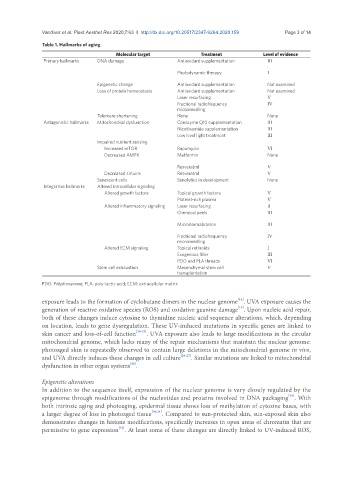Page 739 - Read Online
P. 739
Vandiver et al. Plast Aesthet Res 2020;7:63 I http://dx.doi.org/10.20517/2347-9264.2020.159 Page 3 of 14
Table 1. Hallmarks of aging
Molecular target Treatment Level of evidence
Primary hallmarks DNA damage Antioxidant supplementation III
Photodynamic therapy I
Epigenetic change Antioxidant supplementation Not examined
Loss of protein homeostasis Antioxidant supplementation Not examined
Laser resurfacing V
Fractional radiofrequency IV
microneedling
Telomere shortening None None
Antagonistic hallmarks Mitochondrial dysfunction Coenzyme Q10 supplementation III
Nicotinamide supplementation III
Low level light treatment III
Impaired nutrient sensing
Increased mTOR Rapamycin VI
Decreased AMPK Metformin None
Resveratrol V
Decreased sirtuins Resveratrol V
Senescent cells Senolytics in development None
Integrative hallmarks Altered intracellular signaling
Altered growth factors Topical growth factors V
Platelet-rich plasma V
Altered inflammatory signaling Laser resurfacing II
Chemical peels III
Microdermabrasion III
Fractional radiofrequency IV
microneedling
Altered ECM signaling Topical retinoids I
Exogenous filler III
PDO and PLA threads VI
Stem cell exhaustion Mesenchymal stem cell V
transplantation
PDO: Polydioxanone; PLA: poly-lactic acid; ECM: extracellular matrix
[18]
exposure leads to the formation of cyclobutane dimers in the nuclear genome . UVA exposure causes the
[19]
generation of reactive oxidative species (ROS) and oxidative guanine damage . Upon nucleic acid repair,
both of these changes induce cytosine to thymidine nucleic acid sequence alterations, which, depending
on location, leads to gene dysregulation. These UV-induced mutations in specific genes are linked to
skin cancer and loss-of-cell function [20-23] . UVA exposure also leads to large modifications in the circular
mitochondrial genome, which lacks many of the repair mechanisms that maintain the nuclear genome:
photoaged skin is repeatedly observed to contain large deletions in the mitochondrial genome in vivo,
and UVA directly induces these changes in cell culture [24-27] . Similar mutations are linked to mitochondrial
[28]
dysfunction in other organ systems .
Epigenetic alterations
In addition to the sequence itself, expression of the nuclear genome is very closely regulated by the
[29]
epigenome through modifications of the nucleotides and proteins involved in DNA packaging . With
both intrinsic aging and photoaging, epidermal tissue shows loss of methylation of cytosine bases, with
a larger degree of loss in photoaged tissue [30,31] . Compared to sun-protected skin, sun-exposed skin also
demonstrates changes in histone modifications, specifically increases in open areas of chromatin that are
[32]
permissive to gene expression . At least some of these changes are directly linked to UV-induced ROS,

